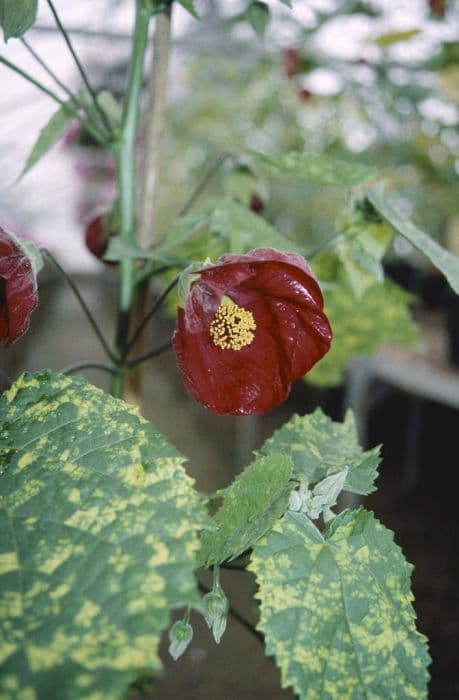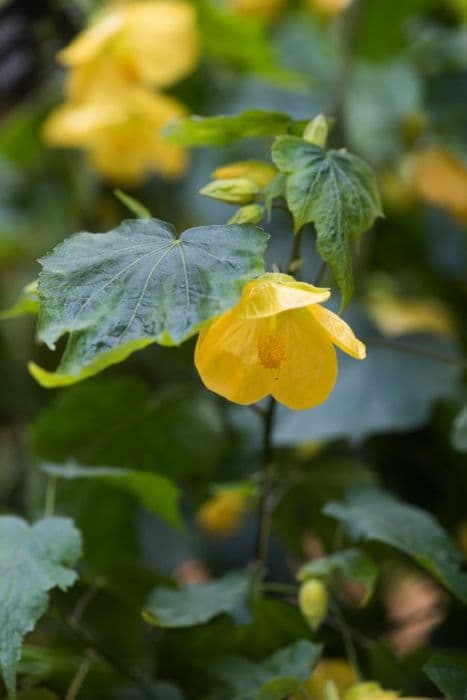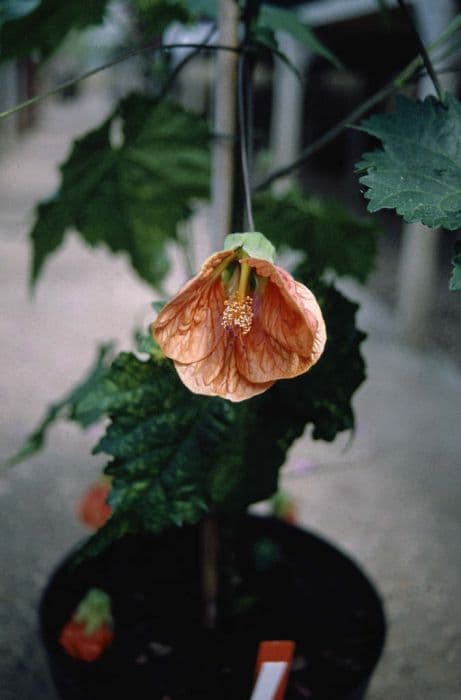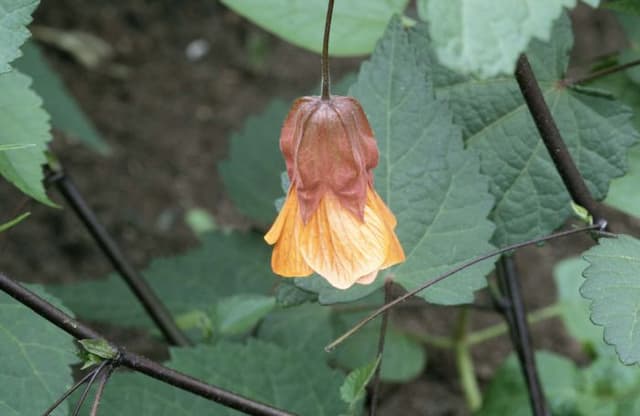Cape Mallow Anisodontea 'El Rayo'

ABOUT
Anisodontea 'El Rayo', commonly known as Cape Mallow, is a striking plant with a bushy and branching habit. The foliage of Cape Mallow is glossy, with each leaf displaying a deep green hue and a slightly serrated edge which gives it a textured appearance. The leaves are generally heart-shaped, which adds a touch of softness to the overall aesthetic of the plant. What stands out most are the flowers, which are abundant and showy. Each blossom of Cape Mallow sports five petals and can range in color from pale pink to a more intense magenta, often with deep veins highlighting their striations which provides a lovely contrast to the slightly lighter background color of the petals. The flowers tend to have a pronounced, ornate center with darker markings that can appear almost black, creating a stunning visual focal point. Cape Mallow may bloom for a long period, offering a continual display of its charming flowers which can attract butterflies and other pollinators. The contrast between the dark centers of the flowers and the bright petals makes this plant a vibrant addition to any garden, providing a splash of color that's visually arresting. Despite the exclusion of specific measurements, Cape Mallow has a size that allows it to be a substantial presence in a garden space.
About this plant
 Names
NamesFamily
Malvaceae
Synonyms
Cape Mallow, False Mallow
Common names
Anisodontea 'El Rayo'.
 Toxicity
ToxicityTo humans
The Anisodontea 'El Rayo', commonly known as Cape Mallow, does not have well-documented toxicity for humans. However, it is always advisable to exercise caution and avoid ingesting plants that are not known to be edible, as they could potentially cause adverse reactions.
To pets
There is limited information on the toxicity of the Cape Mallow to pets. It is not typically listed as a toxic plant to pets, but as with any non-food plant, ingestion could potentially lead to gastrointestinal upset or other reactions. Always keep an eye on your pets and prevent them from consuming plants that are not explicitly safe for them.
 Characteristics
CharacteristicsLife cycle
Perennials
Foliage type
Semi-deciduous
Color of leaves
Green
Flower color
Pink
Height
3-4 feet (0.91-1.22 m)
Spread
2-3 feet (0.61-0.91 m)
Plant type
Shrub
Hardiness zones
9
Native area
South Africa
Benefits
 General Benefits
General Benefits- Attracts Pollinators: The flowers of Anisodontea 'El Rayo' attract bees and butterflies, which are essential for pollination.
- Low Maintenance: Once established, the plant requires minimal care, making it ideal for gardeners of all levels.
- Drought Tolerant: Adapted to survive with less water, it is a good choice for water-wise gardens and xeriscaping.
- Fast Growing: This plant can grow quickly, providing a lush, full appearance in the garden in a shorter period.
- Long Blooming: Anisodontea 'El Rayo' has a long blooming season, offering flowers throughout spring and summer.
- Visual Appeal: With its vibrant pink flowers, it offers aesthetic value and can enhance the beauty of a garden space.
- Heat Resistant: It can withstand high temperatures, making it suitable for hot and sunny locations.
- Wildlife Habitat: It can serve as shelter and a food source for various insects and birds.
 Medical Properties
Medical PropertiesThis plant is not used for medical purposes.
 Air-purifying Qualities
Air-purifying QualitiesThis plant is not specifically known for air purifying qualities.
 Other Uses
Other Uses- As a natural dye: The flowers of Anisodontea 'El Rayo' may be used to create natural dyes for fabrics or crafting projects.
- Photography and Art: Anisodontea 'El Rayo' provides a vibrant backdrop for photography or can be used as a subject in botanical illustration and painting.
- Educational Tool: This plant can be used in horticultural education to teach about plant care, propagation, and the importance of pollinators.
- Culinary Garnish: Although not widely recognized for edible uses, its flowers could potentially be used as an edible garnish for salads and desserts.
- Homemade Potpourri: Dried flowers of Anisodontea 'El Rayo' can be included in homemade potpourri mixes for a natural fragrance.
- Flower Pressing: Its blooms are suitable for flower pressing, allowing crafters to create pressed flower art, bookmarks, or other decorative items.
- Biodegradable Confetti: Dry petals of Anisodontea 'El Rayo' can be used as biodegradable confetti for eco-friendly celebrations.
- Botanical Sachets: Dried Anisodontea 'El Rayo' flowers can be enclosed in sachets to naturally scent drawers and wardrobes.
- Living Fences: When planted in rows or clusters, Anisodontea 'El Rayo' can be utilized as a living fence or border.
- Bee and Butterfly Gardens: The plant's flowers can attract bees and butterflies, making it a good addition to gardens designed to support these pollinators.
Interesting Facts
 Feng Shui
Feng ShuiThe Cape mallow is not used in Feng Shui practice.
 Zodiac Sign Compitability
Zodiac Sign CompitabilityThe Cape mallow is not used in astrology practice.
 Plant Symbolism
Plant Symbolism- Resilience - Anisodontea 'El Rayo', also known as Cape Mallow, is known for its ability to withstand challenging growing conditions, representing the strength to endure difficult situations.
- Adaptability - As Cape Mallow thrives in various environments, it symbolizes the ability to adapt and prosper in different circumstances and life changes.
- Beauty and Simplicity - With its delicate yet vivid flowers, Cape Mallow illustrates that beauty can be found in simplicity and that it does not have to be ostentatious to be appreciated.
- Survival - This plant's tendency to be drought-tolerant and to survive with minimal care highlights the theme of survival and making the most out of sparse resources.
 Water
WaterThe Cape Mallow should be watered deeply and thoroughly to encourage a strong root system. Allow the top inch of the soil to dry out before watering again, which typically means providing water every week to ten days, depending on the weather and soil drainage. Apply approximately one gallon of water per watering session for a medium-sized plant. Adjust the amount according to temperature and rainfall, reducing frequency during cool, wet periods, and increasing during hot, dry spells.
 Light
LightCape Mallow thrives in full sun to partial shade, but for best flowering, situate it in a location where it receives at least six hours of direct sunlight daily. Avoid deeply shaded areas, as this can reduce blooming and lead to leggy growth.
 Temperature
TemperatureCape Mallow prefers moderate temperatures and will do best when the average temperature is between 50 to 75 degrees Fahrenheit. It can tolerate higher temperatures but may need additional watering. Protect the plant from frost, as it can survive minimum temperatures down to about 30 degrees Fahrenheit, but prolonged exposure to freezing temperatures can be damaging.
 Pruning
PruningPrune Cape Mallow to maintain shape, encourage bushier growth, and remove spent flowers. Light pruning can be done throughout the growing season, but a more substantial cutback can be conducted in late winter or early spring before new growth begins. This timing helps prepare the plant for a robust burst of growth and flowering.
 Cleaning
CleaningAs needed
 Soil
SoilCape mallow prefers well-draining soil with a mix of potting soil, perlite, and compost to encourage healthy growth. Aim for a soil pH between 6.0 and 7.5.
 Repotting
RepottingCape mallow should be repotted every 2 to 3 years to refresh the soil and accommodate root growth.
 Humidity & Misting
Humidity & MistingCape mallow thrives in moderate humidity levels but is adaptable to a range of indoor humidity conditions.
 Suitable locations
Suitable locationsIndoor
Place Cape mallow in bright, indirect light indoors.
Outdoor
Plant Cape mallow in a sunny spot with some afternoon shade.
Hardiness zone
9-11 USDA
 Life cycle
Life cycleAnisodontea 'El Rayo', also known as Cape Mallow, starts its life cycle when its seeds germinate in warm, moist soil; a process that typically occurs in spring. The seedlings then develop into young plants, establishing a root system and producing their first leaves. As they enter the vegetative stage, the plants grow rapidly and continually, provided they receive adequate sunlight, water, and nutrients. Following the vegetative phase, the Cape Mallow enters the flowering stage during warmer months, producing pink to purple flowers that attract pollinators, which are essential for sexual reproduction. Once pollinated, the flowers develop into seed capsules, which, when mature, release seeds, ready to begin a new cycle. In suitable conditions, Cape Mallow can also spread through vegetative propagation and become a perennial, contributing to the plant’s longevity and the establishment of persistent growth in the garden.
 Propogation
PropogationPropogation time
Spring-Early Summer
Anisodontea 'El Rayo', commonly known as Cape Mallow, is often propagated through softwood cuttings. The preferable time for this method is during late spring or early summer when the plant's growth is most vigorous. To propagate, cut a piece of new growth about 4-6 inches (10-15 cm) long just below a leaf node, where the concentration of growth hormones is high. Remove the lower leaves, leaving a few at the top, and dip the cut end into rooting hormone powder to encourage root development. The cutting should then be placed in a well-draining potting mix, ensuring the leaf nodes where you removed leaves are covered in the medium. Maintain consistent moisture and place the cutting in a warm place with indirect sunlight. Roots typically develop within a few weeks, after which the new Cape Mallow plant can be transplanted to a larger pot or directly into the garden.





![Abutilon [Yellow Trumpet]](/_next/image?url=https%3A%2F%2Fplants-admin.emdemapps.com%2Fimages%2Fplants%2F%2Fimages%2F604b5caa8b4fb.png&w=640&q=75)


